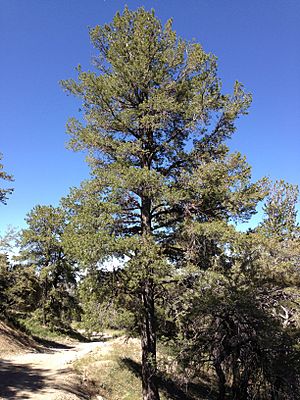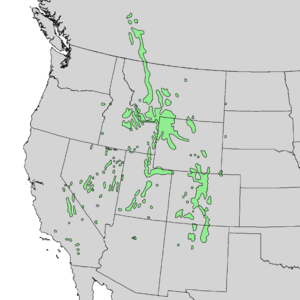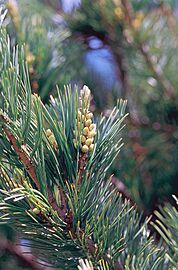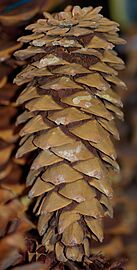Limber pine facts for kids
Quick facts for kids Limber pine |
|
|---|---|
 |
|
| Limber pine on Spruce Mountain, Nevada | |
| Conservation status | |
| Scientific classification | |
| Genus: |
Pinus
|
| Species: |
flexilis
|
 |
|
| Natural range | |
| Synonyms | |
|
|
The limber pine (scientific name: Pinus flexilis) is a type of pine tree. It belongs to the pine family, called Pinaceae. This tree grows in the mountains of the Western United States, Mexico, and Canada. People sometimes call it the Rocky Mountain white pine.
Some limber pines are very old. One in Eagle Cap Wilderness, Oregon, is over 2,000 years old! Another one in Utah, named "Twister," is at least 1,700 years old.
Contents
What Does a Limber Pine Look Like?
The limber pine gets its name because its branches are very flexible, or "limber." Its needles are about 8 centimeters (3 inches) long. They are a dark, bluish-green color. The bark of the tree is dark gray and has many deep creases. The wood inside is pale, light, and soft.
Where Limber Pines Grow
Limber pines usually grow high up in the mountains. They often mark the tree line, which is the edge where trees stop growing due to harsh conditions. They can grow alone or with other trees like whitebark pine or bristlecone pines.
In good conditions, a limber pine can grow to be about 20 meters (65 feet) tall. Sometimes, they can even reach 25 meters (82 feet). However, in windy, exposed places at the tree line, they are much smaller. There, they might only be 5 to 10 meters (16 to 33 feet) tall. In very harsh, rocky areas, mature trees can be less than 3 meters (10 feet) tall.
One of the oldest living limber pine trees is in Alberta, Canada. It is thought to be nearly 3,000 years old!
-
Male cones of a limber pine, eastern Sierra Nevada, California
-
Limber pine cone from San Jacinto Mountains
How to Tell Limber Pines Apart
The limber pine is part of the "white pine" group. Like other white pines, its needles grow in bundles of five. These bundles are called fascicles. This helps tell it apart from trees like the lodgepole pine, which has only two needles per bundle. Bristlecone pines also have five needles per bundle, but their needle bundles have a different kind of base.
Limber Pine vs. Whitebark Pine
It can be tricky to tell a limber pine from a whitebark pine. The easiest way is to look at their cones.
- Limber pine cones are 6 to 15 centimeters (2.4 to 5.9 inches) long. They are green when they are young and open up to release their seeds. Their scales are not easily broken.
- Whitebark pine cones are smaller, 4 to 7 centimeters (1.6 to 2.8 inches) long. They are dark purple when young and do not open on their own. Birds usually break them apart to get the seeds. You will rarely find whole old whitebark pine cones on the ground.
Limber Pine vs. Western White Pine
If there are no cones, you can sometimes tell a limber pine from a Western white pine by feeling their needles.
- Limber pine needles feel smooth when you rub them gently in both directions.
- Western white pine needles feel a bit rough because they have tiny saw-like edges.
Limber pine needles are also usually shorter, about 4 to 7 centimeters (1.6 to 2.8 inches) long. Western white pine needles are usually 5 to 10 centimeters (2 to 4 inches) long.
Where Limber Pines Live
Most limber pines live in the Rocky Mountains. Their range stretches from southwest Alberta and southeastern British Columbia in Canada, south through Colorado and New Mexico, and into northern Mexico. You can also find them in states like Nevada and Utah. They grow in parts of Northern California and Southern California too.
There are also smaller groups of limber pines in eastern Oregon, western North Dakota, Nebraska, and the Black Hills of South Dakota. They can grow at many different heights, from 850 meters (2,790 feet) to 3,810 meters (12,500 feet) above sea level. In the northern parts of their range, they grow at lower mountain elevations. In the southern parts, they grow mainly at high elevations near the upper tree line.
How Limber Pines Help Nature
Limber pines are an important food source for many animals. Red squirrels and Clark's nutcrackers eat their seeds. Clark's nutcrackers are especially important because they help spread the seeds to new places. American black bears and grizzly bears sometimes raid squirrel hiding spots to find limber pine nuts.
Squirrels, Northern flickers (a type of bird), and mountain bluebirds often build their nests in these trees. Some scientists believe that limber pines have a special relationship with tiny bacteria that live in their needles. These bacteria help the tree get important nutrients.
Limber pines can grow well even in shady areas and are good at surviving fires. They tend to grow in places where other types of trees might struggle.
Threats to Limber Pines
Limber pines face a serious threat from a disease called white pine blister rust. This disease is caused by a fungus that came from Europe. Many limber pines are dying in different areas because of this rust. Scientists are working to find limber pines that are naturally resistant to the disease. They are also studying other types of white pines from Europe and Asia that can fight off the disease.
The trees can also be harmed by bark beetles, especially in areas where there is not enough rain.
Growing Limber Pines
A popular type of limber pine called 'Vanderwolf's Pyramid' is often planted in gardens. It is grown as an ornamental tree because it looks nice.
The Southwestern white pine, which is related to the limber pine, is also popular. People use it as a windbreak tree or a decorative tree because it can handle dry weather. Some people even grow it as a Christmas tree. They like its soft needles and strong branches.
Uses of Limber Pine
The large seeds of the limber pine can be eaten. Native Americans in Montana were known to eat them.
See also
 In Spanish: Pino huyoco para niños
In Spanish: Pino huyoco para niños




